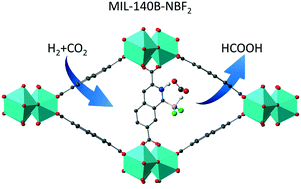The effect of topology in Lewis pair functionalized metal organic frameworks on CO2 adsorption and hydrogenation†
Abstract
We have used density functional theory and classical grand canonical Monte Carlo simulations to identify two functionalized metal organic frameworks (MOFs) that have the potential to be used for both CO2 capture from flue gas and catalytic conversion of CO2 to valuable chemicals. These new materials based on MIL-140B and MIL-140C functionalized with Lewis pair (acid and base) moieties, which are integrated into the framework linkers. We show that the Lewis pair functional groups are capable of catalyzing heterolytic dissociation of H2 and subsequent hydrogenation of CO2 through concerted 2-H addition. We have examined the effect of pore size and framework topology on the competitive binding of H2 and CO2. We show that the small pore size of functionalized MIL-140B stabilizes the formation of a pre-activated CO2 species and that this pre-activated CO2 has a lower overall reaction barrier for hydrogenation of CO2 to formic acid than a competing pathway in the same material that does not go through a pre-activated complex. We demonstrate that steric hindrance can potentially break energy scaling relationships, which limit the ability to optimize traditional heterogeneous catalysts, by independently changing one part of the CO2 hydrogenation pathway, without negatively impacting other parts of the pathway. Specifically, we show that steric effects can reduce the CO2 hydrogenation barrier without impacting the H2 dissociation barrier or binding energy.



 Please wait while we load your content...
Please wait while we load your content...
